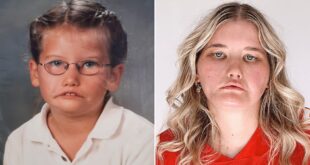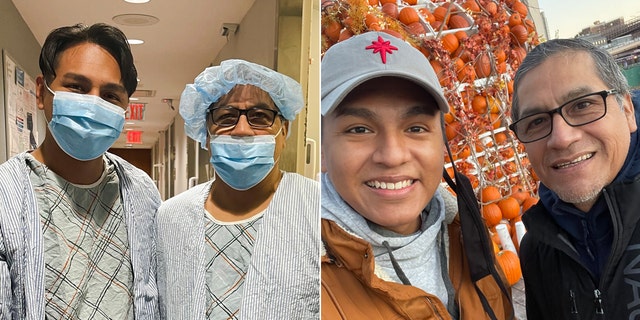
Some dads might get gift cards, steak dinners or new golf clubs for Father’s Day.
Yet Jose Calixto, 56, received something far more significant for the occasion this year.
A few weeks ago, Jonathan Calixto, 30, saved his father’s life by donating a healthy kidney.
“I never hesitated,” the son told Fox News Digital.
FATHERHOOD IS ‘HEROIC ROLE’ FOR MEN, SAYS FILMMAKER AND DEFENDER OF DADS JOHN PAPOLA
Ahead of Father’s Day weekend, father and son revealed how the operation changed their lives.
Easy decision
Jose Calixto, a porter at a New York City building, learned he had kidney disease during a routine physical 10 years ago — an effect of medications he took when he was younger, he said.
He was able to live with the disease without intervention for several years, but his condition took a turn for the worse in mid-2021. Calixto was forced to start dialysis, a treatment that removes waste and toxins from the blood when the kidneys can’t do the job.

Jonathan Calixto, 30 (left), donated a kidney to his dad, Jose Calixto, 56 (right), on March 29, 2023. Fox News Digital spoke to father and son about how the operation changed their lives. (Jose and Jonathan Calixto)
After two years of receiving dialysis three times a week, for four hours per session, Calixto had become so frail and exhausted that he was forced to retire from his job, he told Fox News Digital.
In spite of the dialysis, Calixto’s kidneys were continuing to fail. Ultimately, he was hospitalized.
A transplant was his only option for long-term survival.
TINA TURNER SUFFERED FROM KIDNEY DISEASE BEFORE HER DEATH: ‘I HAVE PUT MYSELF IN GREAT DANGER’
At the time, Jonathan Calixto didn’t know much about what it meant to be a kidney donor, but the decision to donate to his father was a no-brainer for him, he said.
“Living donors really have the ability to change a recipient’s life in a dramatic way.”
To determine if the father and son were a match, they both had to go through a litany of tests at Mount Sinai Hospital in New York City, which has a dedicated transplant center for kidney donors and recipients.
The first step was to find out whether the donor’s and recipient’s blood types were compatible.
This ensured the recipient wouldn’t immediately reject the kidney when it was placed in the body, explained Dr. Vinita Sehgal, Jose Calixto’s primary kidney physician at Mount Sinai.
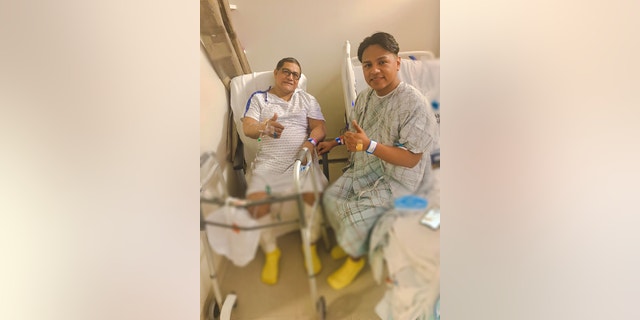
Jose Calixto (left) and Jonathan Calixto are pictured at Mount Sinai Hospital in New York on the morning of their surgery. (Jose and Jonathan Calixto)
“When a donor and a recipient do not have compatible blood types — for example, if a donor with blood type A wants to give a kidney to a recipient with blood type B — a paired exchange, or ‘swap,’ can be arranged with another donor-recipient pair,” Dr. Sehgal explained to Fox News Digital.
Next, they did a histocompatability test, which checks to see if the pair’s tissues match.
There was a 50% chance the Calixtos would have a tissue match.
This test looks at human leukocyte antigens (HLAs), molecules that make up a person’s tissue type.
FRIENDS SHORTEN KIDNEY PATIENTS’ LONG WAITS FOR TRANSPLANTS TO MERE MONTHS BY DONATING ORGANS
“A child to a parent is a 3/6 antigen match, which is a better match than other, non-related donors,” explained Elaine Mitchell, Mount Sinai’s living donor transplant coordinator.
That means there was a 50% chance the Calixtos would have a tissue match.
Dr. Antonios Arvelakis, Jose Calixto’s multi-organ transplant surgeon at Mount Sinai, said he sees cases where children donate to parents and where parents give to children.
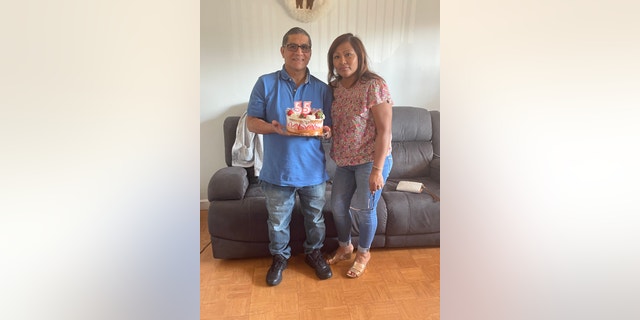
Jose Calixto is pictured on his 55th birthday with his wife, Rosario Calixto, in New York. (Jose Calixto)
“This is the ideal scenario versus getting a donor from a non-relative, because they are typically better matched due to relation,” he explained to Fox News Digital.
Finally, the Calixtos had to do a serum cross-match, which is when the donor’s blood is mixed with the recipient’s to make sure there aren’t any antibodies that would result in the recipient’s immune system’s rejection of the transplant.
“Sometimes, especially when people are blood relatives, they may be very similar genetically, and may even be what is called a ‘perfect match,’” Sehgal said. “This means their immune system is less likely to reject the new kidney.”
“For me, it was never a question. I knew that if I could get the chance, I wanted to do it.”
In February 2023, the Calixtos received the great news: Father and son were a match on all fronts. The doctors gave the green light for the donation process to begin.
UBER DRIVE DONATES KIDNEY TO RIDER HE MET NEARLY 3 YEARS AGO: ‘GOD MUST HAVE PUT YOU IN MY CAR’
Over the next few weeks, the Calixtos each met with their teams of transplant surgeons and coordinators to ensure that both men were healthy and fully committed to the process.
Doctors repeatedly asked Calixto’s son whether he was sure he wanted to go through the organ donation.
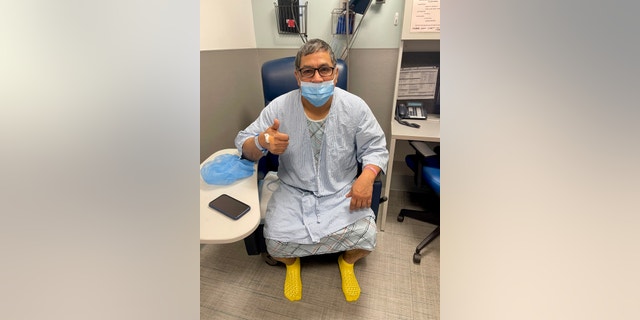
Dad Jose Calixto is shown on the morning of his transplant surgery at Mount Sinai Hospital in New York City. (Jose Calixto)
“They asked me so many times: ‘Are you sure? Do you really want to do this? Are you worried about anything?’” the son said.
“But for me, it was never a question. I knew that if I could get the chance, I wanted to do it.”
With his career as a media host and editor just starting to take off, the younger Calixto knew the surgery could potentially slow his progress — but helping his dad became his main focus.
“Jonathan was committed to his father from the very beginning and did anything necessary to donate to him,” said Mitchell of Mount Sinai.
LIFE AS A PATIENT IN NEED OF ORGAN DONATION: NEW HAMPSHIRE MAN WAITS FOR KIDNEY, READY TO ‘ROCK AND ROLL’
For Jose Calixto’s part, he was “not on board” initially, his son told Fox News Digital.
“He didn’t like the idea of someone giving up a piece of their body, especially his son — it felt like it was going to cut my life in half, in a sense,” Jonathan Calixto said. “So he was hesitant about moving forward at first.”
Calixto became more comfortable with the idea — but was still more concerned about his son’s health than his own.
With more time and research, Calixto became more comfortable with the idea, but was still more concerned about his son’s health than his own.
Any kidney transplant comes with some degree of risks — including bleeding, infection, graft failure and negative reactions to the medications, transplant surgeon Arvelakis said.

Jose and Jonathan Calixto are shown arriving at Mount Sinai Hospital in New York City on the morning of the transplant surgery. (Jose and Jonathan Calixto)
But for the Calixtos, the doctors described the procedure — which took place on March 29 — as “smooth sailing.”
“Jonathan and Jose had no major complications — they both did very well,” Mitchell said.
“Donors usually have a difficult time initially, as they are coming from a healthy position to go through surgery.”
Added Mitchell, “Recipients usually feel better at first, but the healing process is more of a roller coaster, as they take medication to prevent rejection and need monitoring twice weekly, initially.”
Calixto’s son was discharged the very next day with no issues, while Calixto came home three days after the surgery. His body accepted the donated kidney with no significant problems.
Recipients are monitored very closely after surgery, Mitchell said — twice a week for the first month, once a week for the second month and usually once a month for the first year.
During these appointments, the doctors check bloodwork to make sure the kidney is functioning properly and make any necessary adjustments to medications.
For the donors, post-surgery checkups are usually scheduled at six weeks, six months, one year and two years, when doctors will check blood pressure, weight, bloodwork and urine.
“Most people who receive a kidney transplant are able to live normal lives as long as they take their medications, follow up with transplant teams and take precautions.”
After the two-year mark, donors should get annual checkups with their primary care physician, Mitchell said.
“Most people who receive a kidney transplant are able to live normal lives as long as they take their medications, follow up with their transplant teams and take certain precautions,” said Sehgal.
‘Another chance at life’
Two months post-surgery, Calixto and his son are both recovering well and feeling good, they told Fox News Digital.
Calixto is completely off dialysis for the first time in two years and is expected to make a full recovery in about six months.
MEET THE AMERICAN WHO FOUNDED FATHER’S DAY, SONORA SMART DODD, DAUGHTER OF CIVIL WAR VETERAN AND DEVOTED DAD
With his new kidney, Calixto is no longer weak and exhausted. His energy and appetite have skyrocketed, and he is starting to resume some of the activities he couldn’t do while he was on dialysis, he said.
Most importantly, he has hope again — hope that he’ll live a long and healthy life, and that he’ll eventually be able to return to work, he added.
“I’ve been given another chance at life,” Calixto said.
In the meantime, Calixto’s son has returned to work and is feeling “back to normal,” he said.
‘Living donors are heroes’
For people suffering from end-stage kidney disease like Calixto, kidney transplantation is the best-case scenario, Sehgal said.
“While people can live with dialysis treatments for many years, they typically live much longer, and are healthier, with a kidney transplant,” she told Fox News Digital.
“Staying on dialysis long-term increases people’s risks of heart disease, circulatory problems, debility [weakness] and death.”
The wait time for a cadaver kidney (a donation from a deceased person) is typically between four and eight years in the New York area — and nationally, up to half of people on the waiting list will die without ever receiving a transplant, Sehgal pointed out.
“Living donors really have the ability to change a recipient’s life in a dramatic way,” she said.
“They are heroes who are truly giving the gift of life.”
CLICK HERE TO SIGN UP FOR OUR HEALTH NEWSLETTER
About half the kidney transplants that are performed at Mount Sinai each year come from living donors, she added.
For other families suffering from kidney failure, Jose and Jonathan Calixto wholeheartedly encourage donation as a life-saving and life-changing decision.
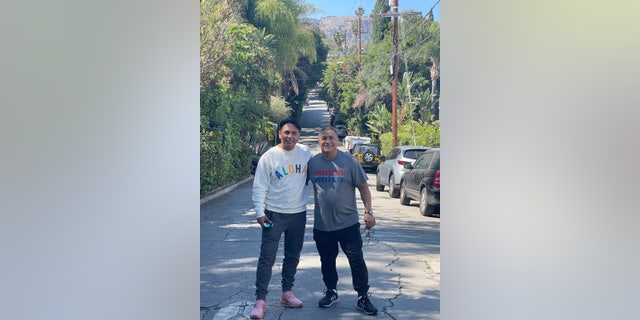
“If you have a loved who is going through kidney failure or is on dialysis, maybe you can be the one who gives them another chance at life,” Jose Calixto said. “I know how much it has meant to me.” (Jonathan and Jose Calixto)
“If you have a loved who is going through kidney failure or is on dialysis, maybe you can be the one who gives [that person] another chance at life,” Calixto said. “I know how much it has meant to me.”
Both father and son are exceedingly grateful for the care they received at Mount Sinai.
CLICK HERE TO GET THE FOX NEWS APP
“I’m super grateful that they took care of us and were able to find a good option, while keeping us healthy and safe,” Calixto’s son said.

 Latest Breaking News Online News Portal
Latest Breaking News Online News Portal

